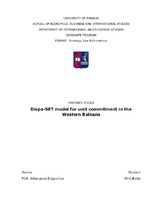| dc.description.abstractEN | Energy plays a significant role in human wellbeing and it has an enormous influence on the global economy and development in general. From the moment when the first Oil Crises happened in the early 1970s it was clear that reforms in Energy Sector must occur. In order to answer better on the challenges in the power systems, researchers and scientists use different energy model and energy system optimization tools. The first signs of energy models occurred during the Second World War but more fruitful period was the period of 70s of the 20th century. From that point on energy modelling never stopped developing. Energy modelling witnessed huge development in the 1990s and at the beginning of 21st century because of the need from those models to answer on various issues. It is generally accepted that there are two types of energy system modelling software: Proprietary and Open source. At the beginning energy models were mainly proprietary and very often results as well as the code were not available. Open source gave a completely new dimension to the energy modelling because software, their code and results became available to everyone and it created community that works together on development of different models. Nowadays, there is a huge variety of different open source energy system models. They are written in different programming languages such as Python, General Algebraic Modelling System (GAMS) and Visual Basic for Applications (VBA). Thanks to the data availability for the Western Balkans region, in this Master thesis Dispa-SET model has been used. Dispa-SET is an open source model for Unit Commitment and Economic Dispatch of the European power system. The aim of this research is to study the power system of the Western Balkans, which includes power systems of Albania, Bosnia and Herzegovina, Montenegro, North Macedonia, Serbia and Kosovo and to examine evolution of these power systems under different scenarios. For that purpose three scenarios for three different years, i.e. 2015, 2020 and 2030 were created and in total 21 simulations were carried out. First 7 simulations covered the reference year 2015, which is used for calculations and comparison of later scenarios. The first simulation in 2015 is carried out for all 6 Western Balkans countries together, while 6 other simulations are carried out for each country individually. Scenarios for the years 2020 and 2030 include increase of power capacities coming from small hydropower plants, solar, wind and biomass power plants. Power systems of each one of the six countries were upgraded by adding additional power capacities so that in total all six countries would have 20%, i.e. 32%, of their total generation capacities coming from the renewables. First simulation for both years is carried out for the region of the Western Balkans in interconnected mode, where all six countries exchange energy between them but there is no exchange with other neighbouring countries. The rest of simulations in both 2020 and 2030 are carried out for each country in islanded mode, which means that there was no power exchange with any of their neighbouring countries. The thesis is structured in four different chapters. The first chapter covers literature review with focus on the evolution of energy models, which is followed by the description of the most popular open source energy models. The second chapter is dedicated to the description and formulation of the Dispa-SET model. In this chapter the objective function is defined. The third chapter deals with the introduction to the Western Balkans region, which is followed by the progress of the European integration of the region and description of the power systems of the Western Balkans. In the last chapter simulation scenarios and results from the simulations for three different years, i.e. 2015, 2020 and 2030 were presented. In the conclusions the results are further discussed with insight for further research. | el |



